Home -
Austria -
Benelux -
Channel Islands -
France & Monaco -
Germany -
Poland -
Russia -
Spain -
Sweden -
Switzerland -
Turkey -
United Kingdom -
United States
Back to reviews in Italy
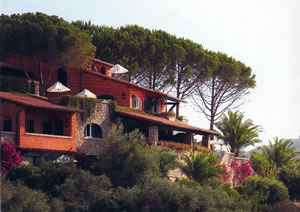 I am as affected by the weather as the next man. During my one hundred mile drive from Rome to Porto Ercole, it rained. It should not have been raining. The season and the location positively forbade rain. But no-one had communicated this prohibition to the black clouds overhead. So it rained. Indeed, it poured, for hour after long hour. My spirits sank as surely as my handling of the hire car deteriorated. It was therefore something of a minor miracle that, having negotiated the final, winding couple of miles from Porto Ercole to the exclusive locality known as Lo Sbarcatello, I suddenly felt quite cheerful. The reason was that I knew immediately that I had arrived at a great hotel. Even though sodden, the gardens were pristine and exquisitely manicured. Within, the entrance lobby was a carefully modulated statement of luxury and good taste, from the handmade tiles on its floor to the plump silk cushions on its sofas. I smiled and I felt at home, as so many do when they come here. It is called the ‘Il Pellicano effect’.
I am as affected by the weather as the next man. During my one hundred mile drive from Rome to Porto Ercole, it rained. It should not have been raining. The season and the location positively forbade rain. But no-one had communicated this prohibition to the black clouds overhead. So it rained. Indeed, it poured, for hour after long hour. My spirits sank as surely as my handling of the hire car deteriorated. It was therefore something of a minor miracle that, having negotiated the final, winding couple of miles from Porto Ercole to the exclusive locality known as Lo Sbarcatello, I suddenly felt quite cheerful. The reason was that I knew immediately that I had arrived at a great hotel. Even though sodden, the gardens were pristine and exquisitely manicured. Within, the entrance lobby was a carefully modulated statement of luxury and good taste, from the handmade tiles on its floor to the plump silk cushions on its sofas. I smiled and I felt at home, as so many do when they come here. It is called the ‘Il Pellicano effect’.
Next morning, I sang the song I was taught as a child: The sun has got his hat on / Hip-hip-hip hooray / The sun has got his hat on and he’s coming out today. And come out he did, fully and generously, bathing the trees of cypress and pine and the winding paths above the sea in his gentle warmth. Indeed, the whole place seemed to open its petals, like a rare and beautiful flower. I sat on the terrace of the restaurant for breakfast and allowed my gaze to wander across the glistening sea to the distant, rugged coastline of the Argentario peninsula. I was reminded of parts of the coast of California, as others had been so reminded in the past.
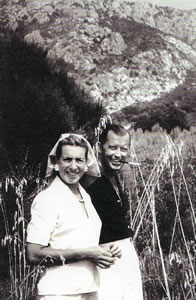 In the 1960s, a British airman, Michael Graham, met an American lady called Patsey Daszel. You will see from the photograph that they were a dashing couple. They fell in love, came to Italy and together built a collection of villas as a select club for their friends. Because the gorgeous spot they chose recalled the part of California where they had met, they used its name and called their haven, ‘The Pelican’. The villas were owned by celebrities and persons of wealth – until, in the 1970s, one of them acquired the whole estate and turned it into the hotel of 50 rooms we see today.
In the 1960s, a British airman, Michael Graham, met an American lady called Patsey Daszel. You will see from the photograph that they were a dashing couple. They fell in love, came to Italy and together built a collection of villas as a select club for their friends. Because the gorgeous spot they chose recalled the part of California where they had met, they used its name and called their haven, ‘The Pelican’. The villas were owned by celebrities and persons of wealth – until, in the 1970s, one of them acquired the whole estate and turned it into the hotel of 50 rooms we see today.
My room, number 4, was on the ground floor of the central building. Designated a ‘Double Sea View’ it was 489-809 euros a night, bed and breakfast for two, according to season. From the corridor three steps took me down into a pristine, air-conditioned bedroom of white, with a beamed ceiling. ‘Pristine’ is a word I could use repeatedly about Il Pellicano, for the entire establishment is spotlessly maintained – but I will forebear. Touches of decorative flair were all about – like the porcelain eagles (table lamps) which stood guard on either side of the beds. The handmade floor tiles I had noticed in the lobby were here, too. Inside the fitted wardrobes was a private safe. A large television with a flat screen was provided for my use. Through the French window was my terrace, with chairs, a table and a view of the sea. White, grey-veined marble encased the bathroom, which had plenty of space for a bidet and a tub of pleasing proportions.
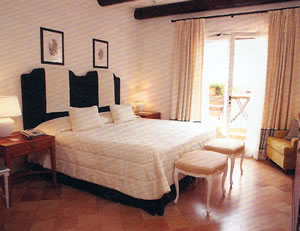 When I arrived, there was only one chair inside the bedroom, but another was brought immediately, when I mentioned this lack of seating to the porter – an example of the efficient and eager service I encountered throughout the hotel. This might suggest that the bedroom was of modest size, and it was. Later I had the opportunity of looking at some of the other accommodation and my advice would be to go for one of the splendidly spacious Deluxe Suites at 889-1,456 euros a night, bed and breakfast for two, according to season.
When I arrived, there was only one chair inside the bedroom, but another was brought immediately, when I mentioned this lack of seating to the porter – an example of the efficient and eager service I encountered throughout the hotel. This might suggest that the bedroom was of modest size, and it was. Later I had the opportunity of looking at some of the other accommodation and my advice would be to go for one of the splendidly spacious Deluxe Suites at 889-1,456 euros a night, bed and breakfast for two, according to season.
I have already mentioned the happy occasion of my first breakfast. Each of my mornings was similarly delightful. I was looked after with exemplary care and attention by the Assistant Maitre d’ Rinaldo Fantoni. He it was who organized my excellent plates of mushrooms on toast (like the rest of the food, of the highest quality) and ensured that the silver pots of coffee on my table were constantly replenished, until it was time for my concluding cappuccino. I myself – often assisted by the friendly waiter, Daniele – brought from the extensive buffet baskets of crusty bread, dishes of stewed pineapple and of fresh melon, plates of crispy bacon, slices of lemon cake and – an innovation to me, and a welcome one – sticks of carrot and celery. You will gather that I did not leave my breakfast table hungry.
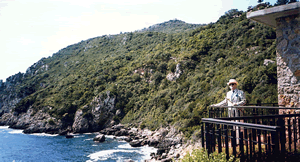 Mediaeval villages and pretty countryside are all around, for those who wish to explore. But my days here were sedentary. Surrounded by cushions, I liked to sit on one of the geranium-bedecked terraces overlooking the gentle waves. Here I read and dozed alternate of a summer’s day. Occasionally, however, I did rouse myself, as my pictures demonstrate. The hotel has a sunbathing area, next to the sea, reached by a lift. The picture shows your correspondent, standing by the railings near the top of the lift. On another day, my gentle perambulation led me to a meeting with one of the mainstays of Il Pellicano’s excellence – the splendid (and splendidly vivacious) General Manager, Francesca Tozzi. She and I are pictured near the main entrance.
Mediaeval villages and pretty countryside are all around, for those who wish to explore. But my days here were sedentary. Surrounded by cushions, I liked to sit on one of the geranium-bedecked terraces overlooking the gentle waves. Here I read and dozed alternate of a summer’s day. Occasionally, however, I did rouse myself, as my pictures demonstrate. The hotel has a sunbathing area, next to the sea, reached by a lift. The picture shows your correspondent, standing by the railings near the top of the lift. On another day, my gentle perambulation led me to a meeting with one of the mainstays of Il Pellicano’s excellence – the splendid (and splendidly vivacious) General Manager, Francesca Tozzi. She and I are pictured near the main entrance.
 Dining at Il Pellicano was a particular joy, for the restaurant has a Michelin star and everyone at the property is clearly proud of its gastronomic reputation. I talked to the Food and Beverage Manager, the jovial Gianni Alocci, who was full of knowledge and enthusiasm about the hotel cellar, which contains a thousand different wines. Each evening, before dinner, a tasting took place in the sitting room – a custom of which I entirely approved.
Dining at Il Pellicano was a particular joy, for the restaurant has a Michelin star and everyone at the property is clearly proud of its gastronomic reputation. I talked to the Food and Beverage Manager, the jovial Gianni Alocci, who was full of knowledge and enthusiasm about the hotel cellar, which contains a thousand different wines. Each evening, before dinner, a tasting took place in the sitting room – a custom of which I entirely approved.
In the dining room I was encouraged to find that my fellow guests had made the effort to dress well for dinner. The atmosphere was thus commendably civilized. On the white tablecloths were good Spiegelau glasses. The sound of the tinkling piano drifted in from the bar, as the waiters in light blue waistcoats moved about the softly-lit room, taking take to replace the napkins of those diners who had left their places for a moment. Through the plate glass windows the sea darkened and drifted towards its sleep.
I sat at table number 25 and looked forward to a good meal. And that is what I received from the kitchen of Chef Antonio Guida. He offers a four course set meal for 110 euros. I chose four courses from the carte for 133 euros. Pretty presentation and delicate flavours characterized this cuisine. Clearly, Mr Guida likes his food to possess subtlety and sophistication, and that seemed entirely as it should be in this luxurious context.
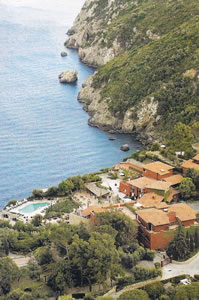 I began with a dish which displayed another characteristic of the food here: subtle and complex taste combinations. This roasted lobster with marsala, hazelnut oil and couscous, with a bisque of moscato, yielded suggestions of the Orient. The following ravioli, with robiola cheese, salsify and Macademia nuts, was delicate and light, and served as a pleasing contrast to my robust main course – rare rib-eye beef with herb butter and green vegetables. I tucked into this fine meat with gusto. My pudding was utterly delicious and was really the highlight of this enjoyable meal: roasted and raw pineapple flavoured with coriander, with pineapple sorbet, coconut and tapioca mousse and blueberry sauce. Then along came the chocolate trolley. (No, I have never encountered one before, either.) But as I am now on the famous Bown Diet – it has only one rule: no chocolate – reluctantly, I allowed this wonder to pass by unmolested.
I began with a dish which displayed another characteristic of the food here: subtle and complex taste combinations. This roasted lobster with marsala, hazelnut oil and couscous, with a bisque of moscato, yielded suggestions of the Orient. The following ravioli, with robiola cheese, salsify and Macademia nuts, was delicate and light, and served as a pleasing contrast to my robust main course – rare rib-eye beef with herb butter and green vegetables. I tucked into this fine meat with gusto. My pudding was utterly delicious and was really the highlight of this enjoyable meal: roasted and raw pineapple flavoured with coriander, with pineapple sorbet, coconut and tapioca mousse and blueberry sauce. Then along came the chocolate trolley. (No, I have never encountered one before, either.) But as I am now on the famous Bown Diet – it has only one rule: no chocolate – reluctantly, I allowed this wonder to pass by unmolested.
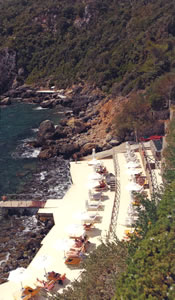 The wine list comprises two substantial volumes – one for the Italian offerings and one for the ‘foreigners’. Both are full of interest. In the former, prices range from 23 euros for a Tuscan chardonnay to 450 euros for the 1996 barbaresco Sorì Tildin from Mr Gaja, with many bottles in the 50-150 euros range. In the foreign book, many of wine-making’s most famous names make an appearance. From France come the 1999 DRC Richebourg (786 euros) and the 1985 Latour (1,039 eurs); Spain is represented by the 1989 Vega Sicilia Unico (382 euros) and California supplies the 1997 Opus One (347 euros). I stayed with the home team, and drank well. The 2006 Cervaro della Salla from Antinori was its usual reliable self, with discreet fruit and a fine structure (31 euros, half), and my Tuscan red made from the sangiovese grape – with its deep flavour of ripe damson and hints of caramel – was superb drinking for only 45 euros (Castello di Monsanto, Fabrizio Bianchi Nemo, 1997). One highly commendable feature of this list is that it gives the alcoholic level of each wine. This is unusual, but it really ought to be standard practice nowadays – especially with some producers (for example, of zinfandel in the United States) reaching levels of 17%.
The wine list comprises two substantial volumes – one for the Italian offerings and one for the ‘foreigners’. Both are full of interest. In the former, prices range from 23 euros for a Tuscan chardonnay to 450 euros for the 1996 barbaresco Sorì Tildin from Mr Gaja, with many bottles in the 50-150 euros range. In the foreign book, many of wine-making’s most famous names make an appearance. From France come the 1999 DRC Richebourg (786 euros) and the 1985 Latour (1,039 eurs); Spain is represented by the 1989 Vega Sicilia Unico (382 euros) and California supplies the 1997 Opus One (347 euros). I stayed with the home team, and drank well. The 2006 Cervaro della Salla from Antinori was its usual reliable self, with discreet fruit and a fine structure (31 euros, half), and my Tuscan red made from the sangiovese grape – with its deep flavour of ripe damson and hints of caramel – was superb drinking for only 45 euros (Castello di Monsanto, Fabrizio Bianchi Nemo, 1997). One highly commendable feature of this list is that it gives the alcoholic level of each wine. This is unusual, but it really ought to be standard practice nowadays – especially with some producers (for example, of zinfandel in the United States) reaching levels of 17%.
As I finally drove away from the hotel, the sun was shining once more. The rain which had accompanied my arrival seemed but a momentary aberration. I felt happy, restored and at peace with myself and with the world. This is what results from staying at a great hotel, where grace, elegance, charm and luxury combine to bestow a therapeutic blessing. This is why, even now, I smile at the memory of my visit to Porto Ercole. I had experienced the ‘Il Pellicano effect’.
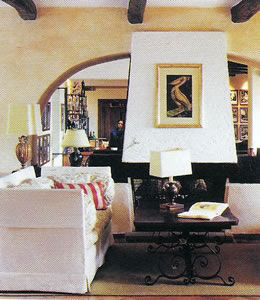
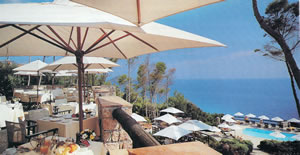
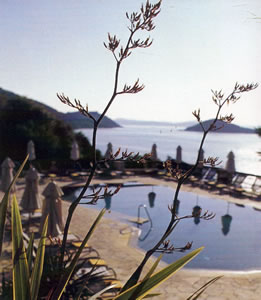
Località Lo Sbarcatello, Porto Ercole 58018, Italy.
Telephone +39 0564 858111
Fax +39 0564 833418
Email: info@pellicanohotel.com
www.pellicanohotel.com
Double rooms from 369-615 euros, according to season, bed and breakfast
Open April to October
**PLEASE NOTE: THE RESTAURANT OF IL PELLICANO NOW HAS TWO MICHELIN STARS.**